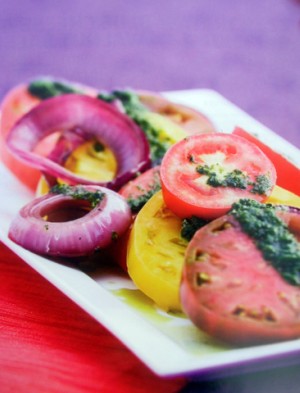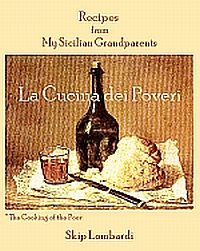Recipes from the Rim: Part I
October 31st, 2007
Heirloom Tomatoes with Olive Oil-Cilantro Sauce
Photo by Gregory Bertolino for Isabel’s Cantina
Fusion food: It’s a natural development in a world where people travel for work and recreation. And even if they stay home, many people see glossy travel and lifestyle magazines with gorgeous food photos, cooking shows on TV, and what we call “food porn” on the Web. American supermarkets, specialty grocers, mail-order businesses, and farmers’ markets now sell ingredients that twenty years ago were not readily available to those living outside major multicultural urban areas. Even in rural areas of the American heartland, convenience stores now sell beer and wines from Australia and Latin America.
As in music—Afro-Celt pop, Polish Reggae, or Yo-Yo Ma’s Silk Road Project—fusion has become a flavor. Sometimes the results are brilliant, and sometimes they are discordant, ill-conceived, and, ultimately, unsatisfying.
One is reminded of the scene in the film Amadeus: Mozart has just played a little harpsichord divertimento for his patron, the Emperor Franz Josef. The Emperor, not the brightest flame in the candelabra, is bewildered by the virtuoso brilliance. He shakes his head and mutters, “Too many notes!”
And that’s our feeling, too, when we see restaurant menus on which each dish requires several lines of text. Here are two offerings reprinted exactly as they appear on current menus of two very hot restaurants—the first in Florida, the second in California.
Grouper Cheeks Sous Vide Faux Watermelon, Jasmine Froth, Amaranth, Torn Herbs, Cucumber Vinaigrette
Salad of “Compressed” Kohlrabi Moro Blood Orange “Confite,” Red Radishes, Mizuna Leaves and Black Sesame “Coulis”
One can say that the popularity of fusion is partly due to the simple fact that it is now possible to combine sounds and tastes from around the globe. If musicians mix Tuvan throat singing with bluegrass and chefs sauce lutefisk with lemongrass, it’s because they can. Whether they should is something listeners and diners eventually determine.
With a different audience each night, a musician or a restaurant chef can see how his creations are received. It’s easier for a restaurant cook to test combinations than it is for someone who has another life and comes home from a day job to prepare a family supper. The recreational home cook who entertains on the weekends may or may not want make his guests guinea pigs for a sea-urchin mousse with wasabi pappadams. (Honestly, I just made that up, but I’ll bet the combo exists on a menu somewhere in NY or LA.) With concoctions like that, the home cook rarely gets a second chance to make a first impression. If the flight of fancy does not work, it’s not likely that he’ll spring it again on his friends. On the other hand, the restaurant chef can tweak things and continue to work on a dish, serving it over and over, with variations, until he gets it right.
In the many books, magazines, online columns, and menus that we see each week, I read recipes and descriptions of scores of fusion dishes. Whether I try them out or not, it appears that, despite the sheer silliness of recipes like those cited above, the better-crafted fusion recipes are coming from restaurant chefs, and that’s probably because they’ve had the theatre in which to develop them.
And since I tend to cook this way, I enjoy fusion food publications—they serve to both confirm and inspire food that I prepare myself.
There are a lot of fusion cookbooks out in the firmament right now. In the next post, I’ll be discussing two newly-released books by chef-restaurateurs. Each is beautifully produced with seductive photos—presentations shot on just the right cobalt plate or wooden platter.
Tune in later this week for commentary on American Masala by Suvir Saran and Isabel’s Cantina by Isabel Cruz, both published by Clarkson Potter.
By Holly Chase



